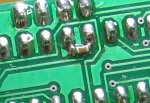Greetings:
I found this of worth, perhaps others will too.
Dangerous Prototypes - A decoupling tutorial with supporting screenshots using a scope. Helps explain the “why”.
DP's introduction (click on the words "excellent tutorial" in line two).
http://dangerousprototypes.com/2011/11/02/decoupling-capacitors-explained/
The article itself.
http://www.vagrearg.org/?p=decoupling
Detail:
The forum has discussed decoupling at length. Senior members have provided excellent tutorials and explanations. They have been read, but for me the concepts didn’t sink in. It had nothing to do with the material and everything to do with my stage in the learning process. Google searches also found many articles but nothing "stuck".
D/P just awarded Bertho the Grand Prize for this years 7400 contest.
http://dangerousprototypes.com/2011/11/02/open-7400-competition-winners/
His tute's introduction reminded me of the car story below.
The screenshots were helpful for a non-engineer like myself.
Bertho’s literary continuity is noted too. A 7400 series chip is the test subject.
Backgrounder:
Growing up, my father gave me the basic tools – wrenches and knowledge - to take care of an auto. He reviewed the information when I bought my 1st car. Sensing the impatience of an 17 year old male, he knew the lectures could only be a certain length.
It was about a year later when, as the dealership mechanic put it, I had “soaked” the engine’s rings by overfilling the crankcase during an oil change. After the spelling lesson ($oaked), the how and why of an engine became more important. Of more interest too. I started buying my own tools. Remember timing lights?
More as an obligation than anything else, decoupling caps have been included in my designs for sometime. Annoyed with board real estate issues, last year I called a friend who is an EE asking "Why?". He replied with a question about water towers. It was then that I began to understand.
Seeing the scope images made the concept stick.
Thanks
Terry
I found this of worth, perhaps others will too.
Dangerous Prototypes - A decoupling tutorial with supporting screenshots using a scope. Helps explain the “why”.
DP's introduction (click on the words "excellent tutorial" in line two).
http://dangerousprototypes.com/2011/11/02/decoupling-capacitors-explained/
The article itself.
http://www.vagrearg.org/?p=decoupling
Detail:
The forum has discussed decoupling at length. Senior members have provided excellent tutorials and explanations. They have been read, but for me the concepts didn’t sink in. It had nothing to do with the material and everything to do with my stage in the learning process. Google searches also found many articles but nothing "stuck".
D/P just awarded Bertho the Grand Prize for this years 7400 contest.
http://dangerousprototypes.com/2011/11/02/open-7400-competition-winners/
His tute's introduction reminded me of the car story below.
The screenshots were helpful for a non-engineer like myself.
Bertho’s literary continuity is noted too. A 7400 series chip is the test subject.
Backgrounder:
Growing up, my father gave me the basic tools – wrenches and knowledge - to take care of an auto. He reviewed the information when I bought my 1st car. Sensing the impatience of an 17 year old male, he knew the lectures could only be a certain length.
It was about a year later when, as the dealership mechanic put it, I had “soaked” the engine’s rings by overfilling the crankcase during an oil change. After the spelling lesson ($oaked), the how and why of an engine became more important. Of more interest too. I started buying my own tools. Remember timing lights?
More as an obligation than anything else, decoupling caps have been included in my designs for sometime. Annoyed with board real estate issues, last year I called a friend who is an EE asking "Why?". He replied with a question about water towers. It was then that I began to understand.
Seeing the scope images made the concept stick.
Thanks
Terry
Last edited:

